Introduction
Nutrition by affecting the brain function may influence the occupational performance of an individual.[1],[2] Many investigators have found that iron deficiency anaemia has a great influence on brain functioning in infants and children.[3],[4],[5],[6],[7],[8],[9],[10],[11] Studies related to this in adult population are few and the outcomes are inconclusive.[12],[13],[14],[15],[16],[17],[18] However inadequate nutrition during adulthood may lead to decreased work efficiency and poor exercise tolerance. Keeping this in view our study was designed to assess the possible impact of nutritional status on brain function among dental students; as the profession of dentistry requires keen recognizing abilities, decision making skills and ample physical stamina.
Materials And Method
After obtaining the ethical clearance from the concerned authority, students of dental sciences were registered for further procedure. First stage of the study involved estimation of haemoglobin level of the participants, by Sahli's method. The second stage of the study involved assessment of the brain function using three set of tests that involved self answering questionnaires.
The first test represented learning style inventory by which learning experience of an individual was analyzed. This inventory contained statements reflecting dependant or directive learning preference, collaborative learning preference and independent learning preference. This practical model is developed by Ronne Toker Jacobs and Barbera Schneider Fuhrmann.[19] As the original inventory did not offer the grading system, it was modified accordingly for the use in our study [Table-1]. The questionnaire contained thirty-six exercises.
 | Tables-1, Grading For Leaning Style Invetory, (Test-1)
 |
The second test (Inventory of Barriers to Creative Thought and Innovative Action) was adopted to identify and measure the degree of inhibitors affecting a person's ability to create and innovate. The questionnaire consisted of thirty-six exercises, set up in a six point Likert-scale format. Each trait was graded according to the scores obtained for classifying each trait into different categories [Table-2,3,4]. The original inventory was developed by Lorna P Martin.[19] This test identifies barriers related to concept of self, need for conformity, ability to abstract, ability to use systematic analysis, task achievement and physical environment. Out of these six traits only scores indicating barriers related to concept of self, task achievement and physical environment were considered for evaluation; as remaining ones were found to be insignificant for our study objectives.
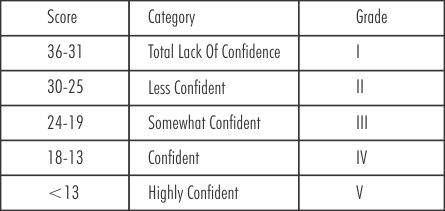 | Table-2, Grading For Confidence Level, (Test-2A)
 |
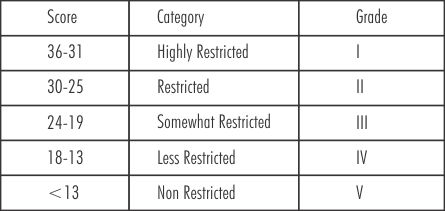 | Table-3, Grading For Work Pattern, (Test-2B)
 |
 | Table-4, Grading For Physical Distraction, (Test-2C)
 |
The questions evaluating confidence level examined variables associated with individual's self esteem, self confidence, handling of rejection and ability to confront differing opinions. Work pattern was determined by exploring variables associated with individual's task achievement qualities, attitudes toward others and resourcefulness. Questions determining physical distraction examined variables associated with individual's preferences as to physical surroundings, dealing with distractions, use of personal space and need for privacy.
The third test evaluated Cognitive Style. The questionnaire consisted of forty exercises, half of which pertained to the systematic style and half to the intuitive style set up in a six point Likert-scale format.[19] [Table-5] The test identified patterns of behaviour that demonstrate a person's approach to critical activities. This multidimensional model of cognitive style reflecting people's behaviour with regard to thinking, learning, especially problem solving and decision making, was created by Martin, where as the descriptions of the systematic and intuitive styles were based on the model created by Kenney & Keen.[19]
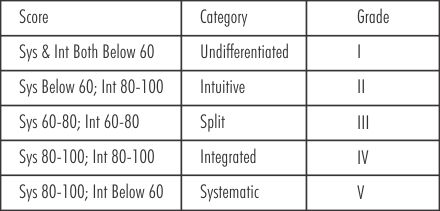 | Table-5, Grading For Congnitive Style, (Test-3)
 |
The study participants were asked to identify and to 'tic' mark for the appropriate answer key, and scoring was done accordingly.
Results And Discussion
The cross-sectional study was designed and conducted in the Department of Oral Medicine and Radiology, Darshan Dental College & Hospital, Udaipur, Rajasthan. A total of 206 participants involving undergraduate and postgraduate students of the institution were evaluated, out of which 150 (73%) were female, and 56 (27%) were male candidates.
The first stage of the study revealed that the mean haemoglobin level of female participants was 10.4gm/dL and that of male participants was found to be 11.6gm/dL. Only 13 (8%) female participants had the haemoglobin level within the normal range.
On evaluating the results of the first brain test representing Learning Experience it was found that no participant scored Grade-I, and the minimum score (Grade-II) obtained by the female participant(n=1) was 12 and by the male participant (n=1) was 14, and their corresponding haemoglobin levels were 10g/dL and 10.4g/dL respectively. The maximum test score (Grade-V) was 36 in females (n=1) and 34 in males (n=1), their corresponding haemoglobin levels were 12g/dL and 12.6g/dL. The scores of the majority of individuals (n=96; f=73; m=23) ranged between 29 and 36 (Grade-V), and their corresponding mean haemoglobin level was 10.36g/dL and 11.85g/dL respectively. [Table-6]
 | Table-6, Comparison Between The Grades Of Test-1 And Hb%.
 |
The outcome of first brain function test revealed that no participant had very poor learning experience, whereas majority of female and male participants scored good and very good scores. [Table-6] The observations of our study indicate that better learning experience was associated with higher haemoglobin level in both female and male participants. Correlation of different grades of this test with haemoglobin level revealed significant results in female participants ®= 0.05) and male participants (r= 0.21) [Table-11]. Similar observations have been reported by R. Bandhu[4], Gabr M. Sayed[5], D. Ivanovic[2], R. Sungthong[7], and A. Nemati[10].
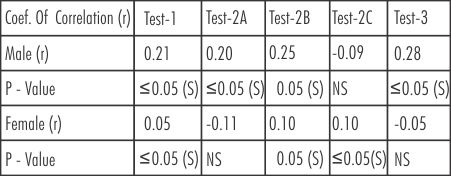 | Table-11, Results Of Statistical Analysis For Coeficiency Of Correlation
 |
On evaluating the scores representing Confidence Level it was found that minimum score (Grade-V) attained by the female participant (n=1) was 11 and by the male participant (n=1) was 9, and their corresponding haemoglobin levels were 12.4g/dL and 12g/dL. The maximum score (Grade-II) in female and male participants was 28 (n=1) and 33 (n=1), and their corresponding haemoglobin levels were 10.6g/dL and 10.4g/dL. The majority (n=103; f=71; m=32) had score between 13 and 18 (Grade-IV), their corresponding mean haemoglobin level was 10.40g/dL and 11.83g/dL respectively. [Table-7]
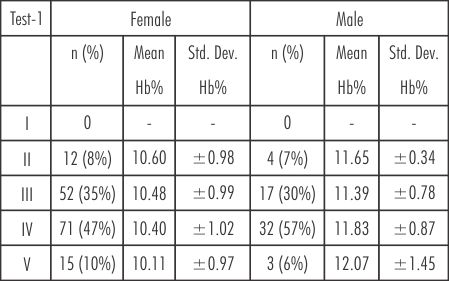 | Table-7, Comparison Between The Grades Of Test-2a And Hb%.
 |
The above findings suggest that individuals with who were found to be more confident were having higher haemoglobin level compared with the individuals who were less confident.
On evaluating the scores representing Work Pattern it was found that minimum score (Grade-V) attained by the female participant (n=1) was 8 and by the male participant (n=1) was 7, and their corresponding haemoglobin level was 12.2g/dL. The maximum score (Grade-III) in female (n=3) was 22 and their corresponding haemoglobin levels were 9.6g/dL, 10g/dL and 11.4g/dL respectively. The maximum score (Grade-II) in male participant (n=1) was 27, and his corresponding haemoglobin level was 10.6g/dL. The majority (n=122; F=92; M=30) had score between 13 and 18 (Grade-IV), and their corresponding mean haemoglobin levels were 10.46g/dL and 11.89g/dL respectively. [Table-8]
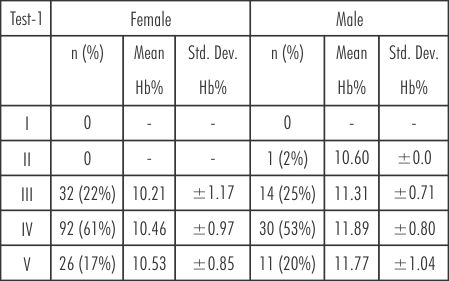 | Table-8, Comparison Between The Grades Of Test-2b And Hb%.
 |
On evaluating the scores representing Physical Distraction it was found that minimum score (Grade-V) attained by the female participants (n=2) was 8 and their corresponding haemoglobin levels were 11.2g/dL and 11.6g/dL. The minimum score (Grade-V) by the male participant (n=1) was 10, and his corresponding haemoglobin level was 12.6g/dL. The maximum score (Grade-III) in female (n=2) was 23 and in male participants (n=1) was 26 (Grade-II) respectively. The corresponding haemoglobin levels of these two female participants were 10g/dL and 11g/dL. The haemoglobin level of the male participant was found to be 12g/dL. The majority (n=107; f=75; m=32) had score between 13 and 18 (Grade-IV) and their corresponding mean haemoglobin level was 10.36g/dL and 11.74g/dL respectively. [Table-9]
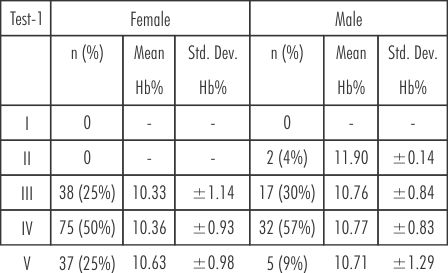 | Table-9, Comparison Between The Grades Of Test-2c And Hb%.
 |
Net outcome of second set of test revealed that no study participant scored grade 1, and maximum number of participants scored grade 4 indicating good level of confidence, less restricted work pattern and less amount of physical distraction respectively [Table-7,8,9]. Coefficient of Correlation of different grades of each of the three parameter of second test with haemoglobin level revealed significant results for work pattern and physical distraction (r=0.1 & 0.1) among female participants, and for confidence level and work pattern among male participants (r=0.20, 0.25). [Table-11] Similar observations have been made by M J Kretsch.[12]
Evaluation of results of the third test representing Cognitive Style revealed that minimum score (Grade-I) obtained by the female participant (n=1) was Sys-58; Int-61 and male participant (n=1) was Sys-57; Int-58. The maximum score (Grade-V) in female participant (n=1) was Sys-94; Int-64 and in male participant (n=1) was Sys-94; Int-64. It was found that majority of study participants (n=164; f=123; m=41) had scores in the following range Sys-60 to 80; Int-60 to 80 (Grade-III). The haemoglobin level of female and male participant who were having minimum score (Grade-I) in the above test was found to be 10g/dL and 10.4g/dL and maximum score (Grade-V) was found to be 12.2g/dL and 11.8g/dL respectively. The majority of females and males had mean haemoglobin of 10.39g/dL and 11.65g/dL respectively. [Table-10]
 | Table-10, Comparison Between The Grades Of Test-3 And Hb%.
 |
The above findings revealed that very few study participants had entirely intuitive approach or systematic approach in solving problems. Majority had the split style that showed individual rating in the middle range on both the systematic and the intuitive scale, involving fairly equal (average) degrees of systematic and intuitive specialization. The observations further indicate that better cognitive ability was associated with higher haemoglobin level among female and male participants. Coefficient of Correlation of different grades of this test with haemoglobin level revealed significant results in females (r=-0.05) and male participants (r= 0.28). [Table-11]
Conclusion
The impact of nutrition on intelligence is one of the most important factors in understanding the differences in brain function among humans. Nutrition by affecting the brain function may influence the occupational performance of an individual.[1],[2],[5] In last two decades, many interdisciplinary studies have been carried out to determine the factors that influence functioning of brain. One theory is partially accepted is that anaemia via cerebral hypoxia and other possible mechanisms, to have a major influence on brain function.[6],[7],[8]
To best of our knowledge no previous reports are available regarding any study been conducted on students of dentistry. The criteria for planning the study are derived from suggestions made by Paul B Jacobson,[13] Te Pin NG,[14] and Duska Petranovic.[3] Almost all the studies that were referred dealt only with the influence of nutrition upon cognitive abilities. Our study involved assessment of personal skill as well as overall brain function of students of dentistry as the profession of dentistry demands keen ability to recognize, understand and apply the knowledge of the science, as well as ample physical stamina to perform operative procedures and withstanding stress.
Observations of our study indicates that the performance of the study participants depended significantly on the level of haemoglobin concentration and the correlation was directly proportional in majority of study objectives. At the same time the non significant results of our study dose remind us about the fact that the brain function also depends on other factors especially the interest of doing and the basic knowledge about the system. We recommend further studies in this regard.
References
1. O.S. Ijarotimi and K.T. Ijadunola. Nutritional Status and Intelligence Quotient of Primary School Children in Akure Community of Ondo State, Nigeria. Tanzania Health Research Bulletin; 2007; Vol. 9; No. 2: 69-76
2. D. Ivanovic, et al. Nutritional Status, Brain Development and Scholastic Achievement of Chilean High School Graduates From High and Low Intellectual Quotient and Socio-Economic Status. British Journal Of Nutrition; 2002; 87(1): 81-92
3. Duska Petranovic, Vladimir Taki, Renata Dobrila-Dintinjana, Ika Ron-Evi-Greta, Klementina Ru-I, Sanja Janovi, Iva Crnari, Antica Duleti-Na-Inovi And Brankica Sin-Mijandru. Correlation of Anaemia and Cognitive Functions Measured By The Complex Reactiometer, Drenovac. Coll. Antropol; 2008; 32: 47-51
4. R. Bandhu, N. Shankar, O. P. Tandon and N. Madan . Effects of Iron Therapy on Cognition in Anaemic School Going Boys. Indian J Physiol Phaemacol; 2003; 47(3): 301-310
5. Gabr M. Sayed, Mohammed F. Kaseem and Yehia M. Hassan. Nutritional Status & Its Impact on Health, Intellectual Development and Scholastic Achievement in Pre-School and Primary School Children in Cairo. Bull. Nutr. Inst. Cairo;1990;Egypt;Vol-10, No-1:43-59
6. Buzina-Suboticanec, Kornelija, Buzina, Ratko; Stavljenic, Ana, Tadinac-Babic, Meri; Juhovic-Markus, Vesna. Effects of Iron Supplementation on Iron Nutrition Status and Cognitive Functions in Children. Food and Nutrition Bulletin.; 1998; 4: 298-306
7. R. Sungthong, L. Mo-Suwan, and V. Chongsuvivatwong. Effects of Haemoglobin and Serum Ferritin on Cognitive Function in School Children. Asia Pacific Journal Of Clinical Nutrition; 2002; 11(2):117-122
8. A. Sen and S.J. Kanani. Deleterious Functional Impact of Anaemia on Young Adolescent School Girls. Journal Of Indian Pediatrics; 2006;Vol-43:219-226
9. HJPS. Sachdev, T. Gera, P. Nestel. Effects of Iron Supplementation on Mental Motor Development in Children. Systematic Review of Randomized Controlled Trails. Public Health Nutritional; 2005; 8(2):117-132
10. A Nemati, M Barak, M H Dehgan. Relation Between Iron Deficiency and Anemia with School Success, Weight and Height in Schoolgirls Aged 12 Year Old in Ardebil Province of Iran. Research Journal Of Biological Sciences; 2007; 2(3): 263-267
11. Dian Kusumadewi, Saptawati Bardosono, Rini Sekartini. Dietary Iron Intake, Serum Ferritin and Haemoglobin Levels, and Cognitive Development Scores of Infants Aged 6-8 Months. Med J Indones; 2011; 20:46-49
12. M J Kretsch, A K H Fong, M W Green and H L Johnson. Cognitive Function, Iron Status, and Haemoglobin Concentration in Obese Women. Food and nutrition bulletin; July 1998, Vol. 52 No. 7: 512-518
13. Paul B. Jacobsen, Linda L. Garland, Margaret Booth-Jones, Kristine A. Donovan, Christina L. Thors, Erin Winters and Edward Grendys. Relationship of Haemoglobin Levels to Fatigue and Cognitive Functioning Among Cancer Patients Receiving Chemotherapy. Journal of Pain and Symptom Management; 2004; Vol. 28 No. 1:7-18
14. Te-Pin Ng, Lei Feng, Mathew Niti, Keng Bee Yap. Albumin, Haemoglobin, BMI and Cognitive Performance in Older Adults. Age & Ageing; 2008; 37:423-429
15. Eman Khedr, Sherifa A Hamed, Esam Elbeih, Hala El-Shereef, Yousreyia Ahmad, Safaa Ahmed. Iron States and Cognitive Abilities in Young Adults: Neuropsychological and Neurophysiological Assessment. European Archives of Psychiatry and Clinical Neuroscience; 2008; Vol-258:489-96
16. Laura E Murray-Kolb, John L Beard. Iron Treatment Normalizes Cognitive Functioning in Young Women. Am J Clin Nutr 2007; 85: 778-87
17. Lucca U, Tettamanti M, Mosconi P, Apolone G, Gandini F, Nobili A, Tallone MY, Detoma P, Giacomin A, Clerico M, Tempia P, Guala A, Fasolo G, Riva E. Association Between Mild Anaemia and Physical and Mental Impairments in The Elderly. Plos One; 2008; 3(4):e1920
18. Raj C. Shah, Robert S. Wilson, Yuxiao Tang, Xinqi Dong, Anne Murray, David A. Bennett. Relation of Haemoglobin to Level of Cognitive Function in Older Persons. Neuroepidemiology; 2009; 32: 40-46
19. The Pfeiffer Library Volume 8, 2nd Edition. Copyright ©1998 Jossey-Bass/Pfeiffer
|